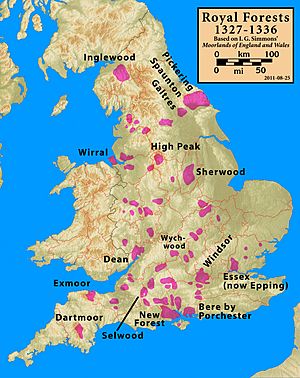Forest of Galtres facts for kids
The Forest of Galtres was a huge royal forest in North Yorkshire, England. It was created by the Norman kings, stretching from the ancient city of York right up to its walls. The main village inside this forest was Easingwold. By 1316, the forest covered a massive 100,000 acres and included 60 villages!
The Forest of Galtres was closely linked to York. A street in York called Davygate was where the forest's court and prison were located. This street was named after David Le Lardiner, whose family were "Royal Lardiners." This meant they were in charge of providing meat, like venison (deer meat), from the forest for the king.
During the time of King Henry II, the Forest of Galtres was at its largest. However, by the 1400s, people started to worry about too many trees being cut down.
Life in the Royal Forest
Besides being a place for kings to hunt deer, the forest was also a very important source of wood. For example, in 1225, wood from Galtres was used to repair the wooden fences and bridges of York Castle.
Royal forests were also valuable for other reasons during the Middle Ages. One important practice was called pannage. This meant letting pigs roam free in the forest to eat fallen acorns, beech nuts, and chestnuts. This was so important that the Domesday Book, a famous survey from 1086, often measured a forest's value by how many pigs it could support!
The king's foresters would collect fees from pig farmers for these rights. In 1319, for instance, they collected money from many farmers, including a pork butcher from York. Sometimes, people were given special jobs in the forest for life. For example, in 1626, King Charles I gave James Rosse the job of looking after the king's deer in Galtres.
Local villagers had traditional rights to let their animals graze in the forest. When these rights were threatened, people sometimes fought back. In 1348, the year of the plague, a group of forty armed men from five villages tore down fences and burned hedges in the Forest of Galtres to protect their rights.
Sheriff Hutton Castle
Inside the Forest of Galtres, a type of castle called a motte-and-bailey was first built at Sheriff Hutton. This was built by Ansketil de Bulmer on land given to him by William the Conqueror. It was rebuilt in 1140 by Bertram de Bulmer, who was the Sheriff of York, during the reign of King Stephen.
The stone Sheriff Hutton Castle that you can still see today was built later, between 1382 and 1398, by John, Lord Neville.
The famous poet John Skelton wrote part of his poem "The Garlande of Laurell" (1523) while at Sheriff Hutton Castle. He described resting by an oak tree stump in the forest:
That me to reste, I lent me to a stump
Of an oke, that sometyme grew full streyghte...
Whylis I stode musynge in this medytatyon
In slumbringe I fell and halfe in a slepe...
From his poem, we learn that Elizabeth, Countess of Surrey, and the ladies of her household were living at the castle at that time.
The Forest of Galtres is even mentioned in William Shakespeare's play Henry IV, Part 2, where it is called "Gaultree Forest."
End of the Forest
In the early 1600s, the Forest of Galtres slowly stopped being a royal forest. This happened because the king needed money. This process is called disafforestation.
In 1625, a survey was done for the sale of land around Sheriff Hutton. This survey mentioned a "ghostly presence" of a former village called East Lilling within the park. Even though only one house remained, old buildings and roads showed it used to be a proper village.
A house known as Sheriff Hutton Park was built in 1621 for Sir Arthur Ingram. Later, in 1732, it was updated for the Thompson family.
Thomas Wentworth, 1st Earl of Strafford tried to buy land in Galtres in 1633. Other people, like Sir John Bourchier, were fined or even put in prison for damaging fences around Strafford's new park. Sir Allen Apsley also received land in Galtres from King Charles I to settle a debt.
Finally, an official law called the Act of Dis-Afforestation in 1629 officially ended the Forest of Galtres.
When York Guildhall was rebuilt after being damaged in World War II, a single oak tree trunk from the former Forest of Galtres was used for each oak pillar.
Legacy of Galtres
The name "Galtres" is still remembered today in North Yorkshire. Several schools are named after it, as well as the Forest of Galtres Golf Course. There was also a music event called the Galtres Festival, which started near Easingwold and later moved to Duncombe Park, Helmsley.


